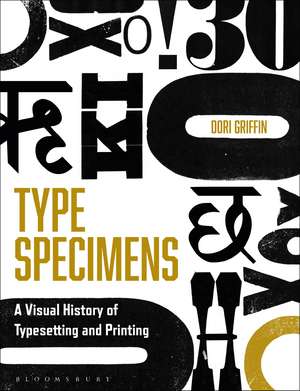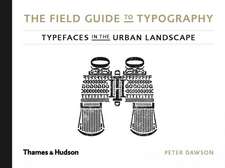Type Specimens: A Visual History of Typesetting and Printing
Autor Professor Dori Griffinen Limba Engleză Paperback – 26 ian 2022
Preț: 179.85 lei
Preț vechi: 190.64 lei
-6% Nou
Puncte Express: 270
Preț estimativ în valută:
34.41€ • 35.50$ • 28.72£
34.41€ • 35.50$ • 28.72£
Carte disponibilă
Livrare economică 06-20 martie
Livrare express 19-25 februarie pentru 52.67 lei
Preluare comenzi: 021 569.72.76
Specificații
ISBN-13: 9781350116597
ISBN-10: 1350116599
Pagini: 256
Ilustrații: 200 color illus
Dimensiuni: 189 x 246 x 16 mm
Greutate: 0.73 kg
Editura: Bloomsbury Publishing
Colecția Bloomsbury Visual Arts
Locul publicării:London, United Kingdom
ISBN-10: 1350116599
Pagini: 256
Ilustrații: 200 color illus
Dimensiuni: 189 x 246 x 16 mm
Greutate: 0.73 kg
Editura: Bloomsbury Publishing
Colecția Bloomsbury Visual Arts
Locul publicării:London, United Kingdom
Caracteristici
Provides context and inspiration for contemporary typographic practice through demystifying techniques and terminology, and showcasing a broad range of historical work and the development of typeface design
Notă biografică
Dori Griffin is an assistant professor in the School of Art + Design at Ohio University, where she teaches graphic design and design history. She earned her MFA in graphic design from the University of Florida and her PhD in design history from Arizona State University. Griffin's primary research centers around the history of popular visual culture and the role that type and image play in creating cultural identity.
Cuprins
Introduction1: Early BroadsidesEarly broadsides: form and functionPragmatic beginnings - the Ratdolt specimen of 1486Patterns of circulationMulti-tasking - specimens serving multiple purposesBroadsides: a lasting form2: Printers' ManualsPrinters' manuals: form and funtionShaping print cultureEstablishing shared knowledge and expectationsExpanding typographic optionsStandardizing printing vocabulariesExpressing visual stylesEvolving tastesConclusion3: Foundry Specimen BooksFormats and functionsComprehensive documentationElaborate displayCommercial utilityStylistic instructionInternational circulationMissionary zealCenters and peripheriesConclusion4: Industrial Methods and MaterialsTools for economizingSaving time, materials and moneyStandardization of formOrganizational redesign - ATF's exampleTools for mechanizationReproduction - electrotyping and the pantographExperiments with machine casting and compositionWood types as "new" toolsAn American (?) inventionAdvantages of wood typeAdvertising at large scaleConclusion5: Hot MetalHot metal: how and whyBenefitsDrawbacksNew formats for the specimenMega-booksLoose-leaf binders and supplements1-line specimensRoles of the specimenCommercial catalogsinstruction manualsDisplay devices for "good" mechanical typeDifferentiation and cooperationProgrammatic world viewsConclusion6: EphemeraNew formatsSupplements to binder systemsLeaflets and brochuresEmerging aesthetic trendsRevisiting historyDefining modernityNetworks of circulationImports, exports and adaptationsCultural specificity and stereotypingLocal, specific, and vernacular forms - Cyrillic and HebrewConclusion7: Photographic and Binary ProcessesPhototype: "inherently superior""Swift & Exact": how phototypesetting worksTypography, dematerializedAttitudes toward technologyInferiority - "the hand is the guide"Innovation - "interesting possibilities"Multiplicity - "for case, matrix, and film"Conclusion - toward a digital futurePostlude: Digital Type, Diverse FuturesBibliographyImage CreditsIndex




